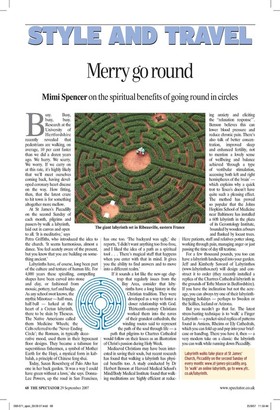Merry go round
Mimi Spencer on the spiritual benefits of going round in circles Busy. Busy, busy, busy. Research at the University of Hertfordshire recently revealed that pedestrians are walking, on average, 10 per cent faster than we did a dozen years ago. We hurry. We scurry. We worry. If we carry on at this rate, it's highly likely that we'll meet ourselves coming back, having developed coronary heart disease on the way. How fitting, then, that the latest craze to hit town is for something altogether more mellow.
At St James's Piccadilly on the second Sunday of each month, pilgrims and passers-by walk a labyrinth, laid out in canvas and open to all. 'It is meditative,' says Petra Griffiths, who introduced the idea to the church. 'It seems harmonious, almost a dance. You feel acutely aware of the present, but you know that you are building on something ancient.'
Labyrinths have, of course, long been part of the culture and texture of human life. For 4,000 years these spiralling, compelling shapes have been carved into stone and clay, or fashioned from mosaic, pottery, turf and hedge.
As any school swot knows, the mythic Minotaur — half-man, half-bull — lurked at the heart of a Cretan labyrinth, there to be slain by Theseus. The Native Americans called them Medicine Wheels; the Celts referred to the 'Never-Ending Circle'; the Romans, in typically decorative mood, used them in their hypocaust floor designs. They became a talisman for superstitious fishermen, a symbol of Mother Earth for the Hopi, a mystical form in kabbalah, a principle of Chinese feng shui.
Today, Susan Rosenberg of Palo Alto has one in her back garden. 'It was a way I could have green without a lawn,' she says. DonnaLee Powers, up the road in San Francisco, 68 THE SPECTATOR 29 September 2007 has one too. 'The backyard was ugly,' she reports, 'I didn't want anything too fi-ou-frou, and I liked the idea of a path as a spiritual tool . . . There's magical stuff that happens when you enter with that in mind. It gives you the ability to find answers and to move into a different realm.'
If it sounds a lot like the new-age claptrap that regularly issues from the Bay Area, consider that labyrinths have a long history in the Christian tradition. They were developed as a way to foster a closer relationship with God. Thirteenth-century Christians worked them into the naves of their grandest cathedrals, the winding routes said to represent the path of the soul through life — a path that pilgrims to Chartres Cathedral would follow on their knees as an illustration of Christ's passion during Holy Week.
Mediaeval Christians may have been interested in saving their souls, but recent research has found that walking a labyrinth has physical benefits too. A study conducted by Dr Herbert Benson at Harvard Medical School's Mind/Body Medical Institute found that walking meditations are 'highly efficient at reducing anxiety and eliciting the "relaxation response". Benson believes this can lower blood pressure and reduce chronic pain. There's also talk of better concentration, improved sleep and enhanced fertility, not to mention a lovely sense of wellbeing and balance achieved 'through a type of vestibular stimulation, accessing both left and right hemispheres of the brain' — which explains why a quick trot to Tesco's doesn't have quite such a pleasing effect. The method has proved so popular that the Johns Hopkins School of Medicine near Baltimore has installed a 60ft labyrinth in the plaza of its Gerontology Institute, bounded by wooden arbours and flanked by locust trees. Here patients, staff and relatives potter along, working through pain, managing anger or just passing the time of day till teatime.
For a few thousand pounds, you too can have a labyrinth landscaped into your garden. Jeff and Kimberly Saward of Labyrinthos (www.labyrinthos.net) will design and construct it to order (they recently installed a replica of the Chartres Cathedral labyrinth in the grounds of Tofte Manor in Bedfordshire). If you have the inclination but not the acreage, you can always try one of their labyrinthhopping holidays — perhaps to Sweden or the Scillies, Iceland or Arizona.
But you needn't go that far. The latest stress-busting technique is to 'walk' a Finger Labyrinth — a pocket-sized replica of patterns found in Amiens, Rheims or Ely Cathedrals, which you can fold up and pop into your briefcase or handbag. There you have it, then — a very modern take on a classic: the labyrinth you can walk while running down Piccadilly.
Labyrinth walks take place at St James' Church, Piccadilly on the second Sunday of every month: www.st-james-piccadilly.org. To 'walk' an online labyrinth, go to www.yfc. co.uk/labyrinth.























































 Previous page
Previous page